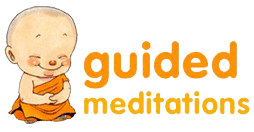
Instruction for Teachers
How to do it?
The meditations for children include five steps:
1) Relaxing the body
2) Deep breathing
3) Concentration of the mind
4) Expansion of the mind
5) Productive activity
1) Relaxing the Body
Some stretching or yoga exercises will be recommended.
After the yoga exercises, have the children tense and relax each body part, starting with the toes and ending with the top of the head. Or you can do the Waterfall Relaxation Meditation with the children.
2) Deep Breathing
i) Gather the children to sit cross legged on the cushions, left palm over the right palm;
ii) Keep the back straight and also relaxed as that will allow a natural flow of energy up and down the spine;
iii) Have the children close their eyes;
iv) Practise deep breathing for a few moments.
a) Breathe in to a count of three, hold the breath and breathe out to a count of three;
b) As you breathe, you breathe in fresh energy, love, joy and peace. They are entering and spreading throughout your body;
c) As you breathe out, imagine any negative feelings — sadness, boredom, anger or tiredness — coming out through your nose and leaving your body and disappearing.
3) Concentration of the Mind
This step is focusing the mind at one point.
I) Visualise a point on your upper lip and concentrate at that point. Draw all the energy and attention into that point while staying very relaxed. Let any stray thoughts or memories pass through, always gently drawing the attention back to the point.
4) Expansion of the Mind
Once the children’s bodies, emotions and minds are quiet, they are ready for the fourth step: true meditation -turning inside for their own answers and wisdom. Guide the children to expand their imagination and awareness through guided imagery. By using guided imagery, the children will learn to see themselves on a movie screen in their minds as a caring, loving, patient person. This will aid them to perform better as a human being as their thoughts are slowly being transformed into wholesome and positive ones.
5) Productive activity
i) Slowly bring your attention back to your body. Feel all your body parts. Slowly wriggle your fingers and toes. Rotate your head. When you are ready, slowly open your eyes.
It is now time for the fifth step:
Grounding the newfound energy, wisdom, insights and heightened awareness into some useful and productive activity. Direct the children to channel this newly focused energy and creativity into dance, art, story writing, music, sharing, class discussions, creative communication, awareness games or academic work.
The tone of voice to use
Please remember that when you are speaking, you will do so in a very slow, relaxed voice, pausing to let the scene sink in, so that the child, whose eyes are closed and who is focusing inward, can easily visualise and feel the scene. The way you use your voice is very important. You will find it best to drop your voice by a few tones, speaking more and more slowly, with a soothing quality.

